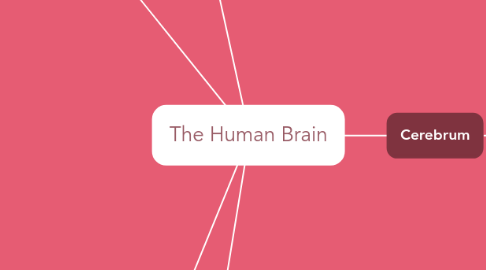
1. Brainstem
1.1. Pons
1.1.1. Links to Cerebellum to help with:
1.1.1.1. Posture
1.1.1.2. Movement
1.1.2. Promotes Sleep
1.2. Medulla
1.2.1. Heartrate
1.2.2. Breathing
1.3. Relay Center
1.4. Automatic Functions
1.4.1. Breathing
1.4.2. Heartrate
1.4.3. Body Temperature
1.4.4. Sleep Cycles
1.4.5. Digestion
1.4.6. Sneezing
1.4.7. Coughing
1.4.8. Vomiting
1.4.9. Swallowing
1.5. Midbrain
1.5.1. Helps to regulate:
1.5.1.1. Body Movement
1.5.1.2. Vision
1.5.1.3. Hearing
1.6. Reticular Formation
1.6.1. Nerve Network
1.6.2. Controls Arousal
2. Cerebellum
2.1. The "Little Brain"
2.2. Under the cerebrum
2.3. Muscle Movements
2.4. Posture
2.5. Balance
2.6. Older than the Cerebrum
2.7. Coordination
3. Limbic System
3.1. Hypothalamus
3.1.1. Master Control of the Autonomic System
3.1.2. Controls:
3.1.2.1. Hunger
3.1.2.2. Thirst
3.1.2.3. Sleep
3.1.2.4. Body Temperature
3.1.2.5. Blood Pressure
3.1.2.6. Emotions
3.1.2.7. Hormones
3.2. Thalamus
3.2.1. Sensory Switchboard
3.2.2. Attention Span
3.2.3. Pain Sensation
3.2.4. Alertness
3.2.5. Memory
3.3. Amygdala
3.3.1. Responds to:
3.3.1.1. Emotions
3.3.1.2. Memories
3.3.1.3. Fears
3.4. Hippocampus
3.5. Pituitary Gland
3.5.1. "Master Gland"
3.5.2. Controls other Endocrine Glands
3.5.3. Secretes Hormones to promote:
3.5.3.1. Sexual Development
3.5.3.2. Bone and Muscle Growth
3.5.3.3. Stress Response
3.5.3.4. New Topic
4. Spinal Cord
4.1. Central Nervous System
4.2. "Internet of Nerve Signals"
4.3. Functions Independently
4.4. Controls Muscles
4.5. Small Diameter
4.6. Stops Growing at age 5
4.7. Memory for pain
5. Cerebrum
5.1. Cerebral Cortex
5.1.1. Folded Appearance
5.1.1.1. Increases Brain Surface Area
5.1.1.2. Folds are called Gyrus
5.1.1.3. Grooves are called Sulcus
5.1.2. 16 Billion neurons
5.2. Occipital Lobe
5.2.1. Interprets Vision
5.2.1.1. Color
5.2.1.2. Light
5.2.1.3. Movement
5.3. Temporal Lobe
5.3.1. Wernicke's Area
5.3.1.1. Understanding Language
5.3.2. Memory
5.3.3. Hearing
5.3.4. Sequencing
5.3.5. Organization
5.4. Frontal Lobe
5.4.1. Personality
5.4.2. Behaviour
5.4.3. Emotions
5.4.4. Judgement
5.4.5. Planning
5.4.6. Problem Solving
5.4.7. Broca's Area
5.4.7.1. Speaking
5.4.7.2. Writing
5.4.8. Motor Strip
5.4.8.1. Body Movement
5.4.9. Intelligence
5.4.10. Concentration
5.4.11. Self-awareness
5.5. Parietal Lobe
5.5.1. Language
5.5.2. Sensory Strip
5.5.2.1. Touch
5.5.2.2. Pain
5.5.2.3. Temperature
5.5.3. Interpretation of:
5.5.3.1. Vision
5.5.3.2. Hearing
5.5.3.3. Motor
5.5.3.4. Sensory
5.5.3.5. Memory
5.5.4. Spatial and Visual Perception
5.6. Largest part of the brain
5.7. Left and Right hemispheres
5.7.1. Joined by the Corpus Callosum
5.7.2. Each controls the opposite side of the body
5.7.3. Left
5.7.3.1. Speech
5.7.3.2. Comprehension
5.7.3.3. Arithmetic
5.7.3.4. Writing
5.7.3.5. Dominant for 90% of people
5.7.4. Right
5.7.4.1. Creativity
5.7.4.2. Spatial Ability
5.7.4.3. Artistic Skills
5.8. Higher Functions
5.8.1. Interpreting touch
5.8.2. Vision
5.8.3. Hearing
5.8.4. Speech
5.8.5. Reasoning
5.8.6. Emotions
5.8.7. Learning
5.8.8. Fine Movement
